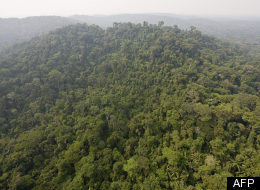The gradual devastation of the Amazon--the felling of thousands of square miles of forest, the clear-cutting of the jungle--has produced, paradoxically, one of the greatest archeological discoveries: a vast and complex ancient civilization. In cleared-away areas of the upper Amazon basin, researchers, using satellite imagery, have recently pinpointed a vast network of monumental earthworks, including geometrically aligned roads and structures, constructed by a hitherto unknown civilization. According to a new report published in the journal Antiquity, the archeologist Martii Pärssinen and other scientists have documented more than two hundred and ten geometric structures, some of which may date as far back as the third century A.D. They are spread out over an area that spans more than two hundred and fifty kilometers, reaching all the way from northern Bolivia to the state of Amazonia in Brazil.
Read the whole story: newyorker.com
via Huffington Post
(...)
Under the Jungle
As I previously wrote about in The New Yorker and in my book “The Lost City of Z,” for centuries most people assumed that the Amazon was a primeval wilderness, a place in which there were, as Thomas Hobbes described the state of nature, “no Arts; no Letters; no Society; and which is worst of all, continual feare, and danger of violent death.” Although the early conquistadores had heard from the Indians about a fabulously rich Amazonian civilization, which they named El Dorado, the searches for it invariably ended in disaster. Thousands were wiped out by disease and starvation. And after a toll of death and suffering worthy of Joseph Conrad, most scholars concluded that El Dorado was no more than an illusion. Indeed, scientists believed that the merciless conditions in the jungle were simply too inhospitable to support a large population, which is a precursor to any sort of large, complex society. The most influential archeologist of the twentieth century, Betty Meggers, famously dubbed the region a “counterfeit paradise.”
In the early nineteen-hundreds, the British explorer Percy Harrison Fawcett challenged this prevailing notion. While exploring and mapping much of the same area where the ruins were recently discovered, he reported finding large earth mounds filled with ancient and brittle pottery. Buried under the jungle floor, he claimed, were also traces of causeways and roadways. Based on this and other evidence, he insisted that the Amazon once contained large populations and at least one, if not more, advanced civilizations. Despite being dismissed and ridiculed as a crank, he set off in 1925 to find the place, which he christened the “City of Z.” He and his party, including his twenty-one-year-old son, Jack, then vanished forever—a fate that seemed to confirm the madness of such a quest.
The latest discovery proves that we are only at the outset of this archeological revolution—one that is exploding our perceptions about what the Amazon and the Americas looked like before the arrival of Christopher Columbus. Pärssinen and the other authors of the study in Antiquity write, “This hitherto unknown people constructed earthworks of precise geometric plan connected by straight orthogonal roads…. The earthworks are shaped as perfect circles, rectangles and composite figures sculpted in the clay rich soils of Amazonia.” The archeologists say they still don’t know if these earthworks, which are made of trenches thirty-six feet wide and ten feet deep, with adjacent walls up to three feet high, were designed for defensive purposes or for ceremonial works. Because of the symmetrical shape of many of the mounds and the way they slant to the north, there is some speculation that they may have had an astronomical purpose.
What is striking about the structures is that their monumentality and sophisticated design are best seen from an aerial view, where they look like an elaborate geometry equation diagrammed in the earth. Pärssinen and the team of scientists estimate that the population at these sites may have been as large as sixty thousand people, and what’s more that the sites found so far represent a fraction of what exists—”only ten percent of what is actually there.” The disappearance of this still mysterious civilization correlates with the arrival of the conquistadores in the Amazon and the spread of diseases. Alas, the discovery of this glorious civilization is due to another tragedy—the vanishing of the once great jungles its people inhabited.
via The New Yorker




































 Monitoramento da Floresta Amazônica Brasileira por Satélite - PRODES
Monitoramento da Floresta Amazônica Brasileira por Satélite - PRODES Sistema de Detecção de Desmatamento em Tempo Real - DETER
Sistema de Detecção de Desmatamento em Tempo Real - DETER


0 comentários:
Enviar um comentário